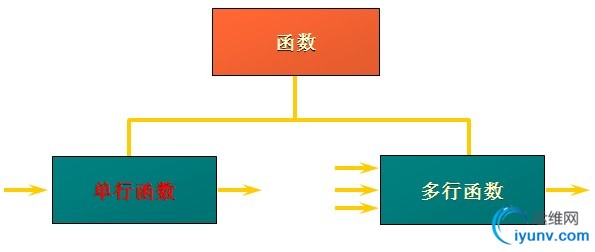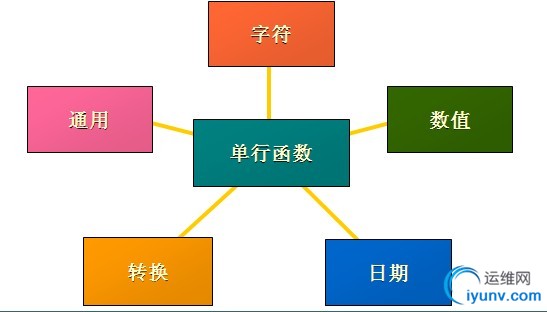|
|
单行函数和多行函数示意图:

单行函数分为五种类型:字符函数、数值函数、日期函数、转换函数、通用函数

单行函数:
--大小写控制函数select lower('Hello World') 转小写, upper('Hello World') 转大写 from dual;--initcap: 首字母大写select initcap('hello world') 首字符大写 from dual;--字符控制函数-- concat: 字符连接函数, 等同于 ||select concat('Hello',' World') from dual;--substr:求母串中的某个子串select substr('Hello World',3) from dual;select substr('Hello World',3,4) from dual;--length和lengthb: 字符数和字节数select length('China') 字符数, lengthb('China') 字节数 from dual;--instr:在母串中,查找子串的位置select instr('Hello World','ll') from dual;--lpad,rpad: 左右填充,将abcd用*填充到10位select lpad('abcd',10,'*') 左填充, rpad('abcd',10,'*') 右填充 from dual;--trim: 去掉字符串前后指定的字符select trim('H' from 'Hello WorldH') from dual;--replace:字符串替换函数select replace('Hello Wordl','l','*') from dual;--数字函数select round(45.926,2) 四舍五入, trunc(45.926,2) 截断 ,mod(1600,300) 求于 from dual;--ROUND函数select round(45.923,0) 整数位, round(45.923,-1) 十位,round(45.923,-2) 百位 from dual;--日期函数--显示当前日期select sysdate from dual;--显示时间部分select to_char(sysdate,'yyyy-mm-dd hh24:mi:ss') from dual;--显示昨天,今天和明天,加减数字仍未日期select sysdate-1 昨天, sysdate 今天, sysdate+1 明天 from dual;--两个日期相减,结果为相差的天数,查询员工信息,显示员工工龄。两个日期不能相加select empno,ename, sysdate-hiredate 天 from emp;--查询员工信息,显示员工工龄,分别按照天,星期,月显示select empno,ename,sysdate-hiredate 天,(sysdate-hiredate)/7 星期, (sysdate-hiredate)/30 月 from emp;--months_between:两个日期相差的月数select (sysdate-hiredate)/30 方式一, months_between(sysdate,hiredate) 方式二 from emp;--add_months:在指定日期上加上若干个月select add_months(sysdate,1) 下个月, add_months(sysdate,123) "123个月后" from dual--last_day: 某个日期当月的最后一天select last_day(sysdate) from dual;--next_day:下周六select next_day(sysdate,'星期五') from dual;--对日期进行四舍五入select round(sysdate,'MONTH') 月,round(sysdate,'YEAR') from dual;--对日期进行截断select trunc(sysdate,'MONTH') 月,trunc(sysdate,'YEAR') from dual;--日期格式select * from emp where hiredate=to_date('1982-01-23','yyyy-mm-dd');-- 查询当前日期:显示: 2011-09-17 15:12:15今天是星期六select to_char(sysdate,'yyyy-mm-dd hh24:mi:ss"今天是"day') from dual;--查询员工信息,显示员工的编号,姓名,月薪,要求有货币代码(L),千位符(,),小数点(.),select empno,ename,to_char(sal,'L9,999.99') from emp;--通用函数--nvl(exp1,exp2):当exp1为空时,返回exp2--nvl2(exp1,exp2,exp3):当exp1为空时,返回exp3;否则返回exp2select ename,sal*12+nvl2(comm,comm,0) 年收入 from emp;--NULLIF (expr1, expr2),如果expr1=expr2,返回null;否则,返回expr1select nullif('abc','abc') from dual;select nullif('abc','abcaa') from dual;--COALESCE :找到参数列表中,第一个不为空的值select ename,comm,sal,COALESCE(comm,sal) from emp;--给员工涨工资,根据职位涨,总裁涨1000,经理涨600 其他人员涨400select ename,job,sal 涨前工资, case job when 'PRESIDENT' then sal+1000when 'MANAGER' then sal+600else sal+400end 涨后工资from emp;select ename,job,sal 涨前工资, decode(job,'PRESIDENT',sal+1000,'MANAGER',sal+600,sal+400) 涨后工资from emp;
多行函数
和单行函数相比,oracle提供了丰富的基于组的,多行的函数。这些函数能在select或select的having子句中使用,当用于select子串时常常都和GROUP BY一起使用。多行函数分为接收多个输入,返回一个输出。
组函数:
--求员工的工资总和select sum(sal) from emp;--求个数select count(*) from emp;--求平均工资select sum(sal)/count(*) 方式一, avg(sal) 方式二 from emp;--关于空值:组函数会自动滤空select count(*), count(comm) from emp;--max和min:求最高工资和最低工资select max(sal) 最高工资,min(sal) 最低工资 from emp;--分组数据:求各个部门的平均工资select deptno,avg(sal) from emp group by deptno;--group by作用于多列: 按部门,不同的工种,统计平均工资--group by作用于多列:先按照第一列分组;如果相同,再按照第二列分组select deptno,job,avg(sal) from emp group by deptno,job;--:求部门的平均工资大于2000的部门select deptno,avg(sal) from emp group by deptno having avg(sal)>2000;--group by的增强select deptno,job,sum(sal) from emp group by rollup(deptno,job);--不同的deptno空两行/取消设置break on deptno skip 2/break on null |
|